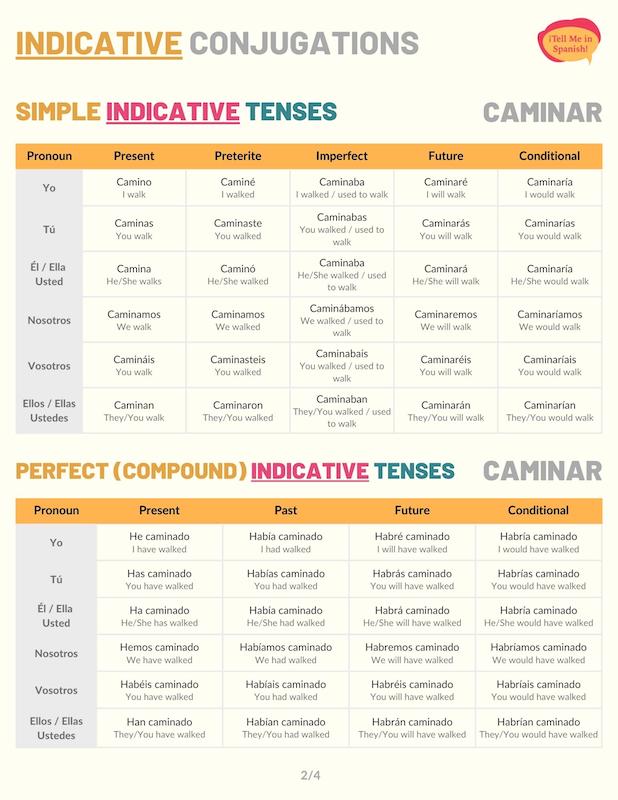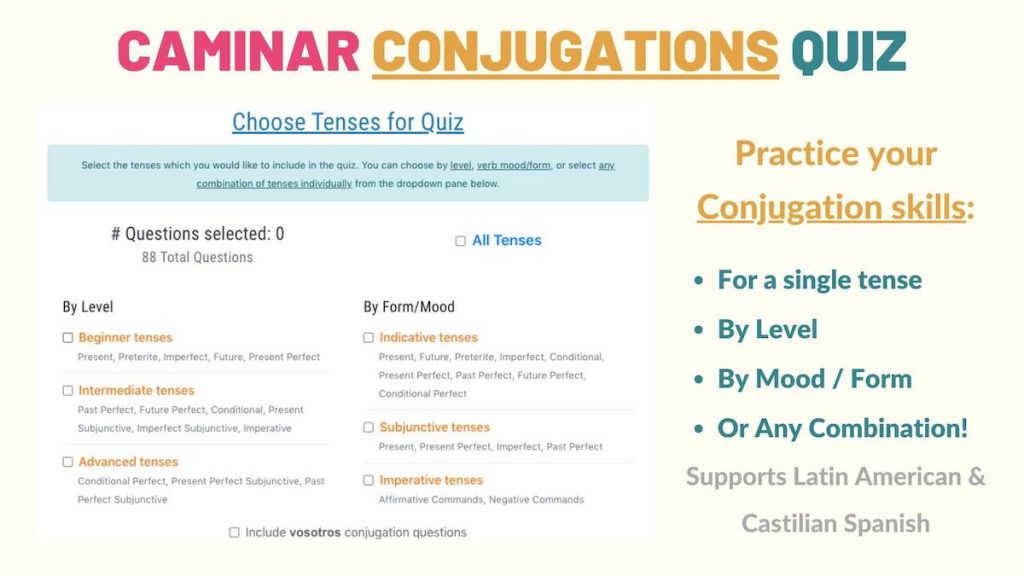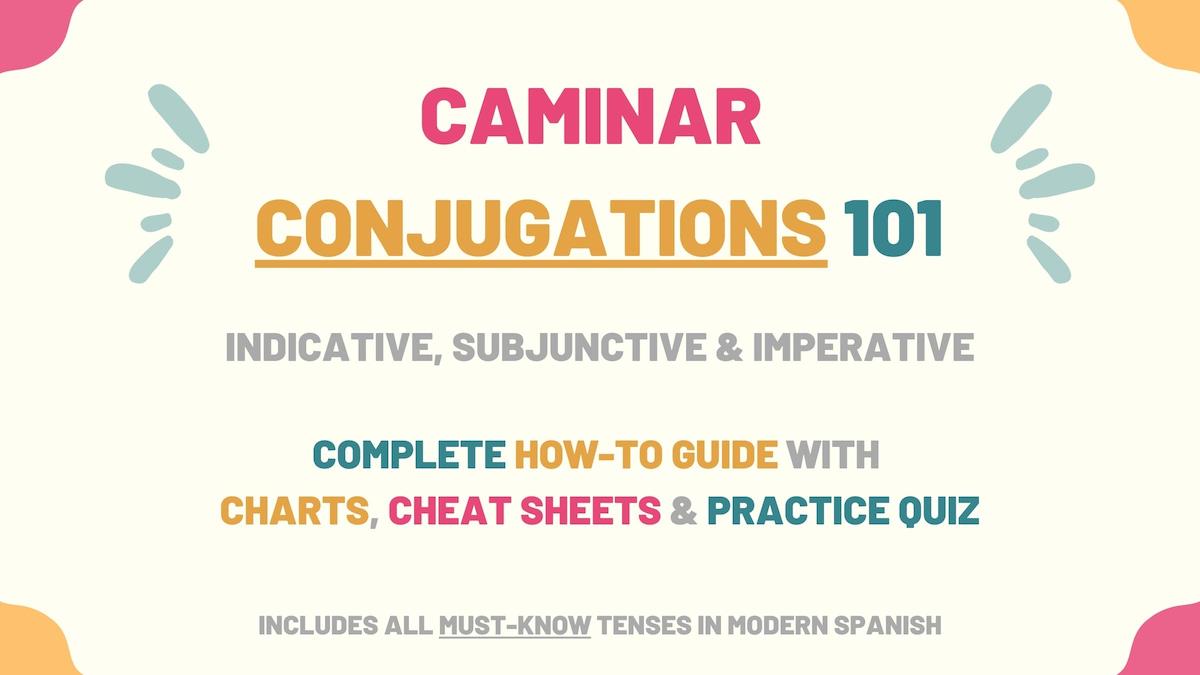Since it’s a regular verb in all tenses, reviewing the caminar conjugation charts can help you learn and practice the patterns for -AR verbs in Spanish. Because it’s also used in daily conversations, in this guide, we’ll learn how to conjugate caminar. Here is what we’ll cover:
- Caminar Overview
- Indicative Tenses of Caminar Conjugations
- Subjunctive Tenses of Caminar Conjugations
- Imperative (Commands) of Caminar Conjugations
- Uses & Examples
- Download Caminar Conjugation Tables & Uses Cheat sheets
- Caminar Conjugation Practice Quiz
Overview of Caminar
| Verb Characteristic | Property |
|---|---|
| Verb Type | -AR |
| Irregular | No |
| Infinitive | Caminar |
| Gerund (Present Participle) Form | Caminando |
| Past Participle Form | Caminado |
| Synonyms | Andar, pasear, ir. |
Indicative Conjugations of Caminar
Present tense
The following caminar conjugation chart shows the endings we must use to conjugate this and other -AR verbs to the present tense. Use the present conjugations of caminar to say that someone walks. For example: María y Jonathan caminan todos los días.
| Person | Conjugation | Translation |
|---|---|---|
| Yo | Camino | I walk |
| Tú | Caminas | You walk |
| Él / Ella Usted | Camina | He/She walks You (formal) walk |
| Nosotros | Caminamos | We walk |
| Vosotros | Camináis | You walk |
| Ellos / Ellas Ustedes | Caminan | They walk You (plural) walk |
Preterite tense
Caminar conjugations in the preterite tense are used to express that someone walked. If applicable to your sentences, you can include an adverb of time in Spanish to explain when this action took place. For instance: El otro día, Sonia y yo caminamos hasta el centro.
| Person | Conjugation | Translation |
|---|---|---|
| Yo | Caminé | I walked |
| Tú | Caminaste | You walked |
| Él / Ella Usted | Caminó | He/She walked You (formal) walked |
| Nosotros | Caminamos | We walked |
| Vosotros | Caminasteis | You walked |
| Ellos / Ellas Ustedes | Caminaron | They walked You (plural) walked |
Imperfect tense
Use the caminar imperfect conjugations to say that someone repeatedly walked in the past or to describe how people used to walk. For example: Nosotros siempre caminábamos a la escuela.
| Person | Conjugation | Translation |
|---|---|---|
| Yo | Caminaba | I walked I used to walk |
| Tú | Caminabas | You walked You used to walk |
| Él / Ella Usted | Caminaba | He/She walked He/She used to walk You (formal) walked You (formal) used to walk |
| Nosotros | Caminábamos | We walked We used to walk |
| Vosotros | Caminabais | You walked You used to walk |
| Ellos / Ellas Ustedes | Caminaban | They walked They used to walk You (plural) walked You (plural) used to walk |
Near future
The near future in Spanish is formed with ir’s present conjugations + a + caminar. You must use this tense to express that someone is going to walk in the immediate future. Here is an example: ¿A qué hora vas a caminar hoy?
| Person | Conjugation | Translation |
|---|---|---|
| Yo | Voy a caminar | I’m going to walk |
| Tú | Vas a caminar | You’re going to walk |
| Él / Ella Usted | Va a caminar | He/She is going to walk You (formal) are going to walk |
| Nosotros | Vamos a caminar | We’re going to walk |
| Vosotros | Vais a caminar | You’re going to walk |
| Ellos / Ellas Ustedes | Van a caminar | They’re going to walk You (plural) are going to walk |
Future simple tense
To conjugate an -AR verb to the future tense, you must add the future endings to the infinitive verb. Caminar future tense conjugations are used to say that someone will walk. Here is an example: Sonia no caminará hasta que su pie se cure.
| Person | Conjugation | Translation |
|---|---|---|
| Yo | Caminaré | I will walk |
| Tú | Caminarás | You will walk |
| Él / Ella Usted | Caminará | He/She will walk You (formal) will walk |
| Nosotros | Caminaremos | We will walk |
| Vosotros | Caminaréis | You (formal) will walk |
| Ellos / Ellas Ustedes | Caminarán | They will walk You (plural) will walk |
Conditional tense
Conjugate this verb to the Spanish conditional tense to convey that someone would walk. You can combine these caminar conjugations with si sentences to present the conditions that need to be met for this action to happen. For instance: Si no me doliera el pie, caminaría más.
| Person | Conjugation | Translation |
|---|---|---|
| Yo | Caminaría | I would walk |
| Tú | Caminarías | You would walk |
| Él / Ella Usted | Caminaría | He/She would walk You (formal) would walk |
| Nosotros | Caminaríamos | We would walk |
| Vosotros | Caminaríais | You would walk |
| Ellos / Ellas Ustedes | Caminarían | They would walk You (plural) would walk |
Present perfect tense
The present forms of haber + caminado (a past participle verb) are the elements we must use to conjugate to the present perfect tense in Spanish. This tense allows you to say that someone has walked. For example: Esta semana he caminado todos los días.
| Person | Conjugation | Translation |
|---|---|---|
| Yo | He caminado | I have walked |
| Tú | Has caminado | You have walked |
| Él / Ella Usted | Ha caminado | He/She has walked You (formal) have walked |
| Nosotros | Hemos caminado | We have walked |
| Vosotros | Habéis caminado | You have walked |
| Ellos / Ellas Ustedes | Han caminado | They have walked You (plural) have walked |
Past perfect
The past perfect tense conjugations of the verb caminar convey that someone had walked before a past action or moment. To form this perfect tense, use haber (imperfect tense) + caminar’s past participle. For instance: Nunca habíamos caminado tanto.
| Person | Conjugation | Translation |
|---|---|---|
| Yo | Había caminado | I had walked |
| Tú | Habías caminado | You had walked |
| Él / Ella Usted | Había caminado | He/She had walked You (formal) had walked |
| Nosotros | Habíamos caminado | We had walked |
| Vosotros | Habíais caminado | You had walked |
| Ellos / Ellas Ustedes | Habían caminado | They had walked You (plural) had walked |
Future perfect
In Spanish, we use the future perfect conjugations of caminar to communicate that someone will have walked. For instance: Al final de este mes, sólo habré caminado diez kilómetros.
| Person | Conjugation | Translation |
|---|---|---|
| Yo | Habré caminado | I will have walked |
| Tú | Habrás caminado | You will have walked |
| Él / Ella Usted | Habrá caminado | He/She will have walked You (formal) will have walked |
| Nosotros | Habremos caminado | We will have walked |
| Vosotros | Habréis caminado | You will have walked |
| Ellos / Ellas Ustedes | Habrán caminado | They will have walked You (plural) will have walked |
Conditional perfect
Conjugate caminar to the conditional perfect tense to express that someone would have walked if a past condition had been met. Check this example: Si hubiera traído dinero, no habría caminado hasta mi casa.
| Person | Conjugation | Translation |
|---|---|---|
| Yo | Habría caminado | I would have walked |
| Tú | Habrías caminado | You would have walked |
| Él / Ella Usted | Habría caminado | He/She would have walked You (formal) would have walked |
| Nosotros | Habríamos caminado | We would have walked |
| Vosotros | Habríais caminado | You would have walked |
| Ellos / Ellas Ustedes | Habrían caminado | They would have walked You (plural) would have walked |
Progressive tenses
To say that someone is walking at the moment of speaking, you must conjugate this verb to the progressive tenses. In this case, you must use the estar conjugations + comer’s present participle form (caminando). Creo que mis papás están caminando.
| Progressive Tense | Formula | Translation Example |
|---|---|---|
| Present | Estar (present) + caminando | I am walking |
| Preterite | Estar (preterite) + caminando | You were walking |
| Imperfect | Estar (imperfect) + caminando | He was walking |
| Future | Estar (future) + caminando | We will be walking |
| Conditional | Estar (conditional) + caminando | They would be walking |
Caminar Subjunctive Conjugations
When a verb is conjugated to the Spanish subjunctive mood, it refers to a person’s requests, wishes, recommendations, hypothetical scenarios, or doubts. In the following sections, we’ll review the most important caminar conjugation charts.
Present subjunctive
The present subjunctive forms of caminar allow you to recommend, demand, or wish that someone walks. For example: Papá, el doctor quiere que camines más.
| Person | Conjugation | Translation |
|---|---|---|
| Yo | Camine | I walk |
| Tú | Camines | You walk |
| Él / Ella Usted | Camine | He/She walks You (formal) walk |
| Nosotros | Caminemos | We walk |
| Vosotros | Caminéis | You walk |
| Ellos / Ellas Ustedes | Caminen | They walk You (plural) walk |
Present perfect subjunctive
The present perfect subjunctive of caminar conveys desires or uncertainty about whether someone has walked. This tense is formed by using haber present subjunctive forms + caminado. Check this sentence: Espero que no hayan caminado en el sol.
| Person | Conjugation | Translation |
|---|---|---|
| Yo | Haya caminado | I have walked |
| Tú | Hayas caminado | You have walked |
| Él / Ella Usted | Haya caminado | He/She has walked You (formal) have walked |
| Nosotros | Hayamos caminado | We have walked |
| Vosotros | Hayáis caminado | You have walked |
| Ellos / Ellas Ustedes | Hayan caminado | They have walked You (plural) have walked |
Imperfect subjunctive
Caminar conjugations in the imperfect subjunctive allow you to talk about someone’s past recommendations, wishes, requests, or expectations about another person walking. For instance: Me gustaría que usted caminara un poco más.
The imperfect subjunctive has two different endings depending on the type of Spanish you’re learning.
Latin American Spanish version
| Person | Conjugation | Translation |
|---|---|---|
| Yo | Caminara | I walked |
| Tú | Caminaras | You walked |
| Él / Ella Usted | Caminara | He/She walked You (formal) walked |
| Nosotros | Camináramos | We walked |
| Ellos / Ellas Ustedes | Caminaran | They walked You (plural) walked |
Note: Vosotros is a plural subject pronoun that is only used in Castilian Spanish. For that reason, it has not been included in the previous caminar conjugation chart.
Castilian Spanish version
| Person | Conjugation | Translation |
|---|---|---|
| Yo | Caminase | I walked |
| Tú | Caminases | You walked |
| Él / Ella Usted | Caminase | He/She walked You (formal) walked |
| Nosotros | Caminásemos | We walked |
| Vosotros | Caminaseis | You walked |
| Ellos / Ellas Ustedes | Caminasen | They walked You (plural) walked |
Past perfect subjunctive
Conjugate caminar to the past perfect subjunctive if you want to say that a person would have walked if a past condition had occurred. You can also use these caminar conjugations to show regret for not walking. Hubieras caminado, no está tan lejos.
| Person | Conjugation | Translation |
|---|---|---|
| Yo | Hubiera caminado | I had walked |
| Tú | Hubieras caminado | You had walked |
| Él / Ella Usted | Hubiera caminado | He/She had walked You (formal) had walked |
| Nosotros | Hubiéramos caminado | We had walked |
| Vosotros | Hubierais caminado | You had walked |
| Ellos / Ellas Ustedes | Hubieran caminado | They had walked You (plural) had walked |
Caminar Imperative Conjugations
To give commands in Spanish, you must conjugate this verb to the negative or the affirmative imperative.
Affirmative commands
Use the caminar affirmative imperative conjugations to order someone to walk. For instance: ¡Caminen más rápido!
| Person | Conjugation | Translation |
|---|---|---|
| Tú | Camina | Walk |
| Usted | Camine | Walk |
| Vosotros | Caminad | Walk |
| Ustedes | Caminen | Walk |
Negative commands
To order someone not to walk, use this verb’s negative imperative forms. For example: No camines, tienes que descansar.
| Person | Conjugation | Translation |
|---|---|---|
| Tú | No camines | Don’t walk |
| Usted | No camine | Don’t walk |
| Vosotros | No caminéis | Don’t walk |
| Ustedes | No caminen | Don’t walk |
Meanings of Caminar & Examples
Now that you’ve learned how to conjugate caminar, let’s check some examples of how to use this verb correctly. In Spanish, this verb is the direct translation of ‘to walk’.
[Caminar conjugated] + [complement]
Gabriel camina muy rápido.
Gabriel walks very fast.
Cindy y yo vamos a caminar al parque.
Cindy and I are going to walk to the park.
Ayer caminé hasta la farmacia.
Yesterday, I walked all the way to the pharmacy.
Take Note: Although it’s the direct translation of ‘to walk’, in Spanish, we don’t say caminar a los perros (walk the dogs). For this case, you can say ‘pasear a los perros’ or ‘sacar a los perros a caminar’. Make sure you conjugate the verbs.
Download Caminar Conjugation Charts & Uses Cheat sheet

Feel free to download a copy of the PDF cheat sheet for this guide. It has all the caminar conjugation charts as well as examples you can use to practice it in your daily conversations.
Practice Quiz: Caminar Conjugation

You’ve now successfully seen how to conjugate caminar in Spanish. The next step is to take the caminar conjugation practice quiz to discover which tenses you’re strong in with regular -AR verbs and which you need to study more.





